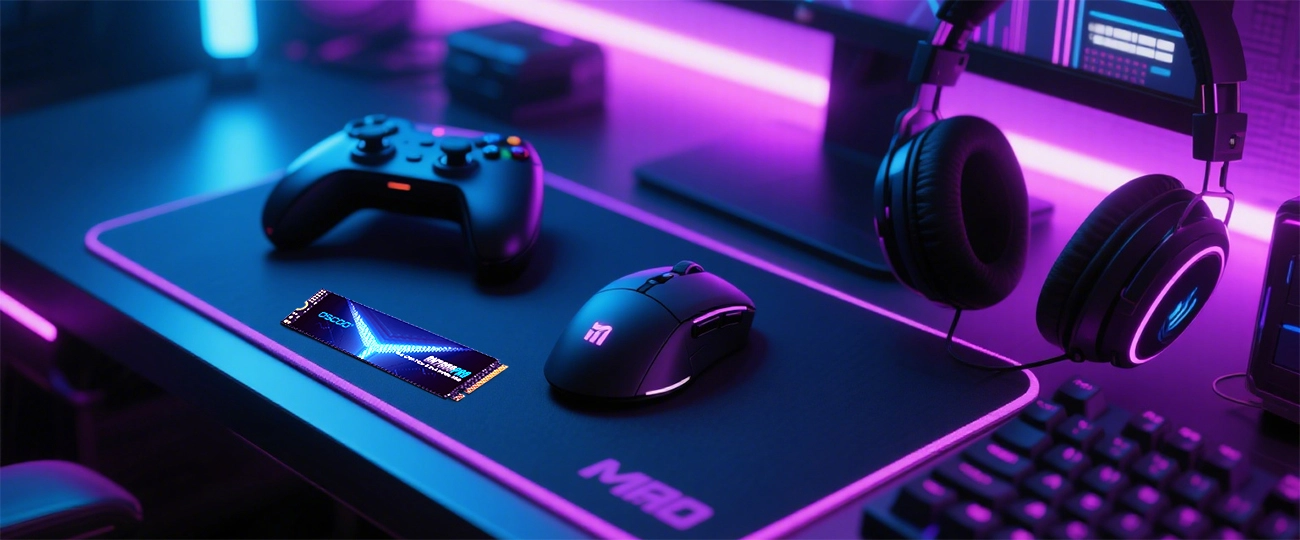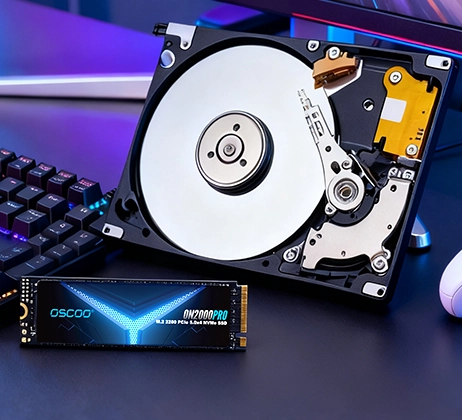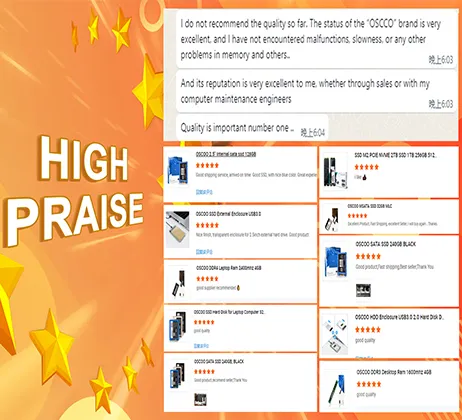If you are a gamer, you will likely recognize this scenario: clicking the game icon and then waiting through a long loading screen, perhaps watching game tips cycle by. When playing large open-world games, occasional stutters or pauses might interrupt your immersion. These problems often stem from traditional hard drives or underperforming solid-state drives.

A good SSD is key to solving these issues. It does more than just shorten loading times from tens of seconds to just seconds. More importantly, it transforms your gaming experience. For games like Cyberpunk 2077 or the vast world of Elden Ring, a good SSD can almost seamlessly load high-resolution textures and complex scenes around you in real-time. This eliminates stuttering and texture pop-in caused by slow drive reading. The result is smoother exploration, uninterrupted combat, and deeper immersion.
As next-generation games increasingly demand faster storage, equipping your gaming setup with a suitable SSD has moved from optional to essential. This guide helps you cut through the technical jargon. It focuses on the core aspects so you can find the best SSD for your gaming device with minimal time and effort, making a smart purchase decision quickly.
Core Metric: Speed, But Look in the Right Place
When discussing SSDs, people often focus first on speed. Manufacturers love highlighting impressive read and write speeds prominently on their packaging. However, not all advertised speeds are equally important for gaming.
First, let’s talk about sequential read/write speeds. This metric measures performance when transferring a single large file, typically in megabytes or gigabytes per second. It makes a big difference when copying a multi-gigabyte game installer or updating a large game, saving significant waiting time. However, its importance decreases during actual gameplay because a game program isn’t a single large file.
Think of it this way: sequential speed is like moving all your furniture with one big truck. Random speed is like having an efficient assistant quickly fetching hundreds of specific small parts from a huge warehouse. For gaming, the efficiency of the latter is more critical. An SSD with excellent random read/write performance drastically reduces scene loading times. It instantly loads new terrain and details when you move quickly, preventing common issues like stuttering or texture delays in open-world games.
Sequential Speeds
- Measures large file transfers
- Important for installing games
- Affects file copying times
- NVMe PCIe 4.0: ~7,000MB/s
Random Speeds (IOPS)
- Measures small file access
- Critical for gameplay smoothness
- Reduces stuttering and pop-in
- Top drives: 1M+ IOPS
Recommendations
- Focus on 4K random read IOPS
- PCIe 3.0 sufficient for most games
- PCIe 4.0 offers future-proofing
- PCIe 5.0 overkill for current games
Our recommendation: for gamers, you should pay more attention to random read/write performance, especially the IOPS value for 4K random reads. Currently, mainstream PCIe 3.0 and PCIe 4.0 SSDs already offer very strong random performance. Both provide extremely smooth gameplay, and the real-world difference between them is much smaller than the gap in their advertised sequential speeds.
Capacity Choice: How Much is Enough?
After determining your speed needs, capacity is the next crucial decision. This choice directly affects how many games you can store on the drive simultaneously. Modern games are growing at an astonishing rate. A typical AAA game often requires 50 to 100GB of space. Popular franchises like Call of Duty can exceed 200GB for a full installation.
Given this, choosing the right capacity is vital. Current mainstream gaming SSD capacities are mainly 500GB, 1TB, and 2TB. A 500GB drive is often insufficient today. It might hold your operating system and one or two frequently played large games, but you’ll quickly end up uninstalling old games to make space for new ones. Therefore, we do not recommend 500GB as your primary gaming drive.
A 1TB capacity is a balanced choice. It offers more flexible space, allowing you to install several large games and other applications simultaneously. It’s a viable starting point for budget conscious gamers. However, from a long-term gaming experience and value perspective, 2TB is currently the best choice for gamers. It provides ample space to maintain a collection of multiple large games. You avoid constantly managing storage space or worrying about the next game update filling your drive. The freedom gained from this significantly improves the experience, far outweighing the price difference compared to 1TB models.
| Capacity | Approx. AAA Games | Best For | Price Point |
|---|---|---|---|
| 500GB | 3-5 | Extremely budget systems | Budget |
| 1TB | 8-12 | Balanced gaming & budget | Mid-range |
| 2TB | 16-25 | Serious gamers & collectors | Premium |
| 4TB+ | 30+ | Hardcore collectors | Enthusiast |
For a small number of hardcore gamers or collectors, 4TB or larger capacities let them keep their entire library installed permanently. However, these are relatively expensive. In summary, our advice is dear: if your budget allows, choose 2TB directly. It’s a wise investment in your gaming experience for the next few years. It frees you from storage anxiety so you can focus on the enjoyment of the games themselves.
Interface & Compatibility: Ensure It Fits Your Device
Once you know the speed and capacity you need, the next vital step is ensuring the SSD you choose is physically compatible with and works correctly in your gaming device. This primarily involves the interface protocol, physical size, and specific requirements for different platforms.
First, focus on the interface and protocol. This sets the foundation for the performance ceiling. The main choices are SATA and NVMe PCIe. SATA III is a more traditional interface with a maximum theoretical speed of around 550MB/s. Its advantages are usually lower cost and extremely wide compatibility; nearly all desktops and laptops have SATA ports. However, its performance limit is becoming a bottleneck for modern gaming devices. It also cannot meet the upgrade requirements for newer devices like the PS5. Therefore, it’s recommended for basic upgrades in older computers.
NVMe PCIe is now the absolute mainstream. It connects directly to the motherboard’s PCIe lanes for speeds far exceeding SATA. Performance varies significantly depending on the version. PCIe 3.0 SSDs can reach speeds up to around 3,500MB/s. This performance is already more than sufficient for game loading and responsiveness. PCIe 3.0 drives also offer excellent value currently. PCIe 4.0 pushes the speed limit to around 7,000MB/s. These are more expensive and are the choice for expanding PS5 storage or PC users seeking peak performance. The latest PCIe 5.0 offers speeds exceeding 10,000MB/s. However, these are currently extremely expensive, generate significant heat, and offer performance far beyond what games require. We do not recommend them for regular gamers.
SATA III
- Max Speed: 550MB/s
- Best for older systems
- Wide compatibility
- Budget friendly
NVMe PCIe 3.0
- Max Speed: 3,500MB/s
- Sweet spot for gaming
- Excellent price/performance
- Widespread support
NVMe PCIe 4.0
- Max Speed: 7,000MB/s
- PS5 compatible
- Future-proofing
- Premium price
NVMe PCIe 5.0
- Max Speed: 10,000+MB/s
- Overkill for gaming
- Expensive
- High heat output
Next is the physical size, also called the form factor. The most common size is M.2 2280. It looks like a stick of gum and plugs directly into the motherboard’s M.2 slot. It requires no separate data or power cables, making installation very clean. This is the most popular form factor in new desktops and laptops. Before buying, confirm your motherboard has an available M.2 slot. Another size is 2.5-inch. This form factor is mainly used for SATA SSDs. It requires connecting both a data cable and a power cable, making installation slightly more involved.
Finally, different gaming platforms have specific SSD requirements.
| Gaming Plaforms | Key Requirements | Additional Notes |
|---|---|---|
| PC Players |
| Ensures the SSD performs at its best. |
| PS5 Upgrade |
| Choosing a model with a built-in low-profile heatsink avoids hassle. |
| Steam Deck / Gaming Handhelds |
| Be absolutely certain of the size before buying, otherwise the drive won’t fit. |
General Advice: Take a few minutes before clicking “buy” to confirm your device’s interface, available slots, and platform-specific requirements. This prevents unnecessary trouble and returns.
Type: Internal or External?
When choosing an SSD for gaming, you might also face this question: should I choose an internal SSD or an external SSD connected via USB? These two types differ fundamentally in performance, convenience, and suitable scenarios.
Internal SSDs connect directly to the system via the motherboard’s M.2 slot or SATA ports. This direct connection provides the lowest latency and highest data transfer efficiency. It allows the drive to perform at its full potential. Whether shortening game loading times or improving open-world smoothness, an internal SSD delivers the optimal experience. Therefore, for desktops, laptops, and PS5s, an internal SSD is the undisputed first choice. It provides a fast and stable home for your game library.
In contrast, external SSDs connect via a USB cable. Their biggest advantage is portability. You can easily carry and transfer games between different computers, plugging and playing quickly. However, their performance is limited by the USB interface speed. Even the fastest USB 3.2 Gen 2×2 interface is significantly slower than an internal NVMe SSD connected directly via PCIe. This results in longer game loading times. Therefore, an external SSD is better suited as supplementary storage. It works well as a portable game library for temporarily taking a few games to a friend’s house or backing up downloaded game files. However, it is not ideal as your primary drive for everyday gaming.
In summary, if your goal is the best gaming experience, you should choose an internal SSD without hesitation. The external option represents a significant compromise in performance for the sake of portability and is only recommended for users with specific mobility needs.
Brand & Warranty: The Foundation of Quality and Assurance
Beyond technical specs, the brand’s reputation and warranty policy are also key considerations. This ensures you’re not just buying fast storage, but also peace of mind for long-term, stable use. Choosing a reputable, well-known brand is often the most effective way to avoid problems. Brands like Oscoo, Samsung, Western Digital, Kingston, and Crucial typically possess stronger technical expertise in NAND flash quality, controller chip development, and firmware optimization. They also have stricter quality control. This means their products usually offer more reliable performance stability, longevity, and compatibility.
The warranty provides an official quality guarantee. When buying, pay close attention to two key metrics: the warranty length and the TBW rating. The warranty length states the total period the manufacturer promises support. The TBW rating represents the total amount of data you can write to the drive during the warranty period. Trusting mainstream brands and carefully reading the warranty terms is the final step to ensure your investment is worthwhile and provides lasting peace of mind.
Choosing an SSD for gaming doesn’t have to be difficult. Remember this key point first: for gaming, sufficient capacity and reliable random read performance are far more important than chasing the highest sequential speeds. Then, focus on your budget, required speed, necessary capacity, device compatibility, and brand reputation. This approach lets you quickly and easily find the perfect SSD. Enjoy the seamless loading experience in your gaming worlds.





